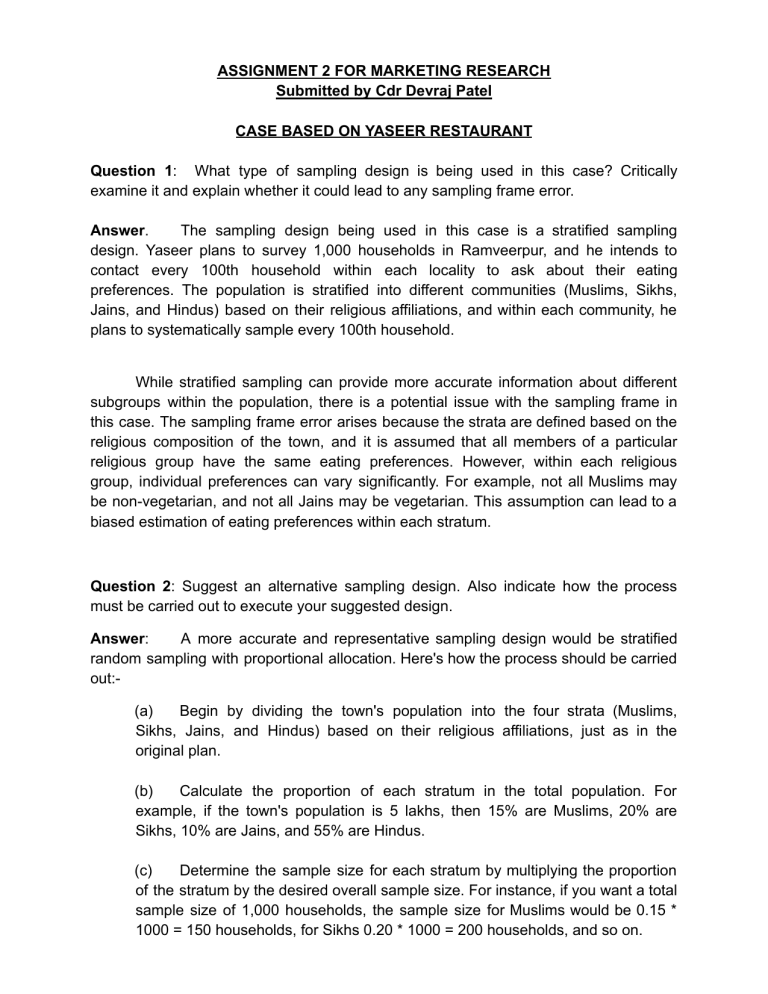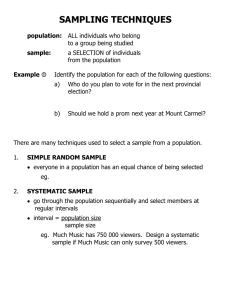Marketing Research Assignment: Sampling Design & Yaseer Restaurant
advertisement

ASSIGNMENT 2 FOR MARKETING RESEARCH Submitted by Cdr Devraj Patel CASE BASED ON YASEER RESTAURANT Question 1: What type of sampling design is being used in this case? Critically examine it and explain whether it could lead to any sampling frame error. Answer. The sampling design being used in this case is a stratified sampling design. Yaseer plans to survey 1,000 households in Ramveerpur, and he intends to contact every 100th household within each locality to ask about their eating preferences. The population is stratified into different communities (Muslims, Sikhs, Jains, and Hindus) based on their religious affiliations, and within each community, he plans to systematically sample every 100th household. While stratified sampling can provide more accurate information about different subgroups within the population, there is a potential issue with the sampling frame in this case. The sampling frame error arises because the strata are defined based on the religious composition of the town, and it is assumed that all members of a particular religious group have the same eating preferences. However, within each religious group, individual preferences can vary significantly. For example, not all Muslims may be non-vegetarian, and not all Jains may be vegetarian. This assumption can lead to a biased estimation of eating preferences within each stratum. Question 2: Suggest an alternative sampling design. Also indicate how the process must be carried out to execute your suggested design. Answer: A more accurate and representative sampling design would be stratified random sampling with proportional allocation. Here's how the process should be carried out:(a) Begin by dividing the town's population into the four strata (Muslims, Sikhs, Jains, and Hindus) based on their religious affiliations, just as in the original plan. (b) Calculate the proportion of each stratum in the total population. For example, if the town's population is 5 lakhs, then 15% are Muslims, 20% are Sikhs, 10% are Jains, and 55% are Hindus. (c) Determine the sample size for each stratum by multiplying the proportion of the stratum by the desired overall sample size. For instance, if you want a total sample size of 1,000 households, the sample size for Muslims would be 0.15 * 1000 = 150 households, for Sikhs 0.20 * 1000 = 200 households, and so on. (d) Use a random sampling method (such as random number generators) within each stratum to select the specified number of households. This ensures that the sample is representative of each religious group's preferences. Question 3: Suggest the possible sample size that should be taken out from each community and why? Answer: The sample size for each community should be based on the proportionate allocation method described above. In this case, the sample sizes for each community would be: (a) Muslim - 150 households (b) Sikhs - 200 households (c) Jains - 100 households (d) Hindus - 550 households This allocation ensures that the sample is proportional to the size of each community in the population, allowing for more accurate estimates of eating preferences within each group while maintaining overall representation.





